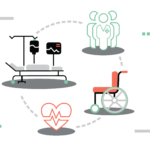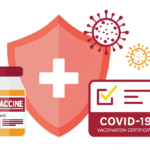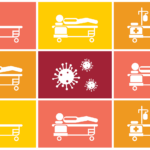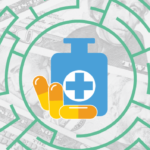The Schaeffer Center White Paper Series is published by the Leonard D. Schaeffer Center for Health Policy & Economics at the University of Southern California. Papers in the series have gone through the Center’s white paper quality assurance process led by the Director of Quality Assurance at the USC Schaeffer Center. This process includes an internal review and review by two scholars not affiliated with the Schaeffer Center.

The Evolving Role of Hospitals and Health Systems in Community Health and Emergency Preparedness
Jan. 24, 2024 | By Erin Trish, PhD, Thomas M. Priselac, MPH, Scott Serota, Melissa A. Frasco, PhD, Ruth Katz, JD, MPH, Nancy-Ann DeParle, Sister Carol Keehan, Julian Harris, Mitchell Katz, Sandra Lindsay, Jonathan B. Perlin, Mike Trachta and Reed Tuckson
Often under financial pressure while being asked to do more, hospitals and health systems need new approaches to ensure high-value care.

Medicare Advantage Enrolls Lower-Spending People, Leading to Large Overpayments
June 13, 2023 | By Steven M. Lieberman, Paul Ginsburg, PhD and Samuel Valdez, PhD
Favorable selection led to Medicare Advantage overpayments on the order of 14.4% in 2020.

Benefits of Medicare Coverage for Weight Loss Drugs
April 18, 2023 | By: Alison Sexton Ward, Bryan Tysinger, PhuongGiang Nguyen, Dana Goldman and Darius Lakdawalla
The cumulative social benefits from Medicare coverage for new obesity treatments over the next 10 years would reach almost $1 trillion, or roughly $100 billion per year.

Mitigating the Inflation Reduction Act’s Adverse Impacts on the Prescription Drug Market
April 13, 2023 | By: Dana Goldman, Joseph Grogan, Darius Lakdawalla, Barry Liden, Jason Shafrin, Kyi-Sin Than and Erin Trish
This paper provides three recommendations to steer the potential effects of the IRA toward its goal of improving patient access while encouraging innovation.

Cancer-Related Technologies Have Changed a Lot. So Should Cancer Screening.
February 15, 2023 | By: Dana Goldman, Darius Lakdawalla and Karen Van Nuys
Current cancer-screening and reimbursement paradigms should be revised to recognize the value of new technologies available.

Price Changes Varied Widely Across California Hospital Systems from 2012 through 2018
August 18, 2022 | By: John Romley, Moonkyung Choi, Erin Trish and Darius Lakdawalla
Growth of hospital systems in the U.S. can facilitate cost savings by reducing inefficiencies. However, a competing narrative suggests hospital mergers can also result in higher prices for patients.

Federal Regulations of Cannabis for Public Health in the United States
July 18, 2022 | By: Rosalie Liccardo Pacula, Seema (Choksy) Pessar, Joy Zhu, Alexandra F. Kritikos and Rosanna Smart
Despite public health risks, high-potency cannabis products are a growing market in states that have legalized cannabis. Federal legalization is an opportunity to implement regulations that better protect consumers and promote reasonable use.

U.S. Consumers Overpay for Generic Drugs
May 31, 2022 | By: Erin Trish, Karen Van Nuys and Robert Popovian
Growing evidence shows that U.S. consumers often overpay for generics as pharmacy benefit managers game opaque and arcane pricing practices to pad profits. Greater transparency across the generic prescription distribution chain and policies to spur competition and deter anticompetitive practices can reduce generic drug costs.

Targeting Affordability in Healthcare: A Review of the Evidence
October 29, 2021 | By: Melissa A. Frasco and Erin Trish
Health plans have many tools to reduce spending and therefore reduce plan premiums, which can improve the affordability of health insurance. Schaeffer experts synthesized the evidence from the last 15 years in the United States on tools that reduce costs or have the potential to drive cost savings

The 340B Drug Pricing Program: Background, Ongoing Challenges and Recent Developments
October 14, 2021 | By: Karen Mulligan
Between 2000 and 2020, the number of covered entity sites participating in the 340B program increased from 8,100 to 50,000.

The Social Value of Disseminating Transcatheter Aortic Valve Replacement
September 28, 2021 | By: Duncan Ermini Leaf, Soeren Mattke, Bryan Tysinger and Darius Lakdawalla
Transcatheter aortic valve replacement (TAVR) has facilitated the treatment of valvular heart disease in patients ineligible or reluctant to undergo open-heart surgery. While rates of TAVR have increased over time, uptake of the procedure remains low.

Advancing the Economics of Palliative Care: The Value to Individuals and Families, Organizations and Society
August 5, 2021 | By: Peter May, Brian Tysinger, R. Sean Morrison and Mireille Jacobson
A palliative care research agenda can help lay the foundation for building a strong evidence base to guide public policies meant to advance affordable, equitable, high-quality, patient-centered care.

Reducing Racial Disparities in Early Cancer Diagnosis With Blood-Based Tests
July 12, 2021 | By: Alison Sexton Ward, Karen Van Nuys and Darius Lakdawalla
Multi-cancer, early detection (MCED) blood-based tests are one solution to reduce disparities in late-stage cancer diagnosis among minority populations. But if adoption of the tests in minority populations is low, they could disproportionately benefit white patients and increase, rather than reduce, racial disparities in early cancer detection.

COVID-19 Vaccination Mandates for School and Work Are Sound Public Policy
July 7, 2021 | By: Karen Mulligan, Jeffrey Harris
Vaccine mandates for employees and students is an effective policy solution to ensure the U.S. reaches herd immunity and avoids future outbreaks.

Impacts of First-in-Class Drug Approvals on Future in-Class Innovation
May 19, 2021 | By: Alison Sexton Ward, Karen Van Nuys and Darius Lakdawalla
Some claim that FDA approval of drugs with uncertain efficacy today will slow future innovation. In fact, the relationship is much more complex.

Reassessing the Value of Minimally Invasive Technologies in the Era of COVID-19
March 17, 2021 | By: Darius Lakdawalla, Dana Goldman, Karen Van Nuys and Dan Mendelson
Minimally invasive technologies are capacity-conserving technologies that could reduce burdens on healthcare providers and hospitals while also shielding patients from unnecessary in-hospital exposure to pathogens.

Health Technology Assessment in the U.S.: A Vision for the Future
February 9, 2021 | By: Darius Lakdawalla, Peter J. Neumann, Gail R. Wilensky, and colleauges
Health technology assessment (HTA) can help achieve the dual health policy goals of ensuring affordability and encouraging innovation.

Prospects for Future Advances in Alzheimer’s Disease
August 18, 2020 | By: Paul Aisen, Jakub Hlávka, Dana Goldman, Paul G. Shekelle, Howard J. Federoff, Caleb E. Finch, Franz F. Hefti, James L. Kirkland, Frank LaFerla, and Aneesa Motala
This paper revisits expert predictions for future advances in Alzheimer’s disease (AD) made in 2001 and projects future breakthroughs over the next 20 years.

Key Barriers for Clinical Trials for Alzheimer’s Disease
August 17, 2020 | By: Dana Goldman, Kristina Malzbender, Lisette Lavin-Mena, Lynne Hughes, Niranjan Bose and Deep Patel
Alzheimer’s disease (AD) clinical trials are more complicated, costly, and slower than trials for other diseases. Addressing barriers would accelerate the approval of innovative therapies.

The Value of Treatment for COVID-19
July 8, 2020 | By: Karen Mulligan, Karen Van Nuys, Desi Peneva, Martha Ryan and Geoffrey Joyce
The COVID-19 pandemic has imposed significant and far-reaching health and economic costs. This paper monetizes the health-related benefits of two hypothetical treatments administered either before or after hospitalization and finds both generate value.

The Economic Case for Public Investment in Stem Cell Research
June 24, 2020 | By: Dana Goldman, Martha Ryan, Bryan Tysinger, Adam Rose, Dan Wei and Mark S. Humayun
Our analysis shows the measure resulted in over 56,000 jobs created and added approximately $10 billion to the state’s economy.

Is the U.S. Ready to Quickly Vaccinate its Population Against COVID-19?
May 6, 2020 | By: Jeff McCombs, Richard Dang, Yurim Rachel Seo, Eric Nguyen, Christopher J. Limbo, Jonathon Lam, and Robert Popovian
Once a COVID-19 vaccine is developed, achieving universal immunization will require a cohesive, multi-faceted vaccination strategy across the U.S. healthcare system.

Getting Americans Back to Work (and School) With Pooled Testing
May 5, 2020 | By: Darius Lakdawalla Emmett Keeler, Dana Goldman and Erin Trish
To reopen safely, employers need to identify workers who have active COVID-19 infections and do so at a reasonable cost. Pooled testing for the coronavirus is an effective, scalable tool for doing so.

How Would Sharing Rebates at the Point-Of-Sale Affect Beneficiary Cost-Sharing in Medicare Part D?
March 17, 2020 | By: Erin Trish, Katrina Kaiser and Geoffrey Joyce
If cost-sharing were based on net price it would provide meaningful financial relief to many Part D beneficiaries.

Health Technology Assessment for the U.S. Healthcare System
February 26, 2020 | By: Karen Mulligan, Darius Lakdawalla, Dana Goldman, Jakub Hlavka, Desi Peneva, Martha Ryan, Peter Neuman, Gail Wilensky, and Ruth Katz
Experts explored how to better link the price of health technologies to the benefits they provide to patients while ensuring a sustainable healthcare ecosystem.

The Association Between Drug Rebates and List Prices
February 11, 2020 | By: Neeraj Sood, Rocio Ribero, Martha Ryan and Karen Van Nuys
Drug rebates and list prices are positively correlated: On average, a $1 increase in rebates is associated with a $1.17 increase in list price.

Hospital System Participation and Hospital Spending
October 28, 2019 | By: Karen Mulligan, John Romley, Seema (Choksy) Pessar and Catherine Ishitani
Most hospital systems span across markets and states with higher system participation were more likely to have below-median per capita hospital spending.

State Drug Pricing Transparency Laws: Numerous Efforts, Most Fall Short
September 25, 2019 | By: Martha Ryan and Neeraj Sood
166 recently enacted prescription drug pricing laws were analyzed to identify those that contained price transparency measures. Of these, 35 bills in 22 states include a transparency component, but only 7 were deemed to be informative.

Value-Based Contracting in Healthcare: What Is It and How Can It Be Achieved?
June 21, 2019 | By: Rebecca Myerson, Jeff McCombs, Yijan Xu and Robert Popovian
Value-based contracts must incentivize the clinical decision-maker, usually the physician, to allocate treatment based on both price and value. Changing certain elements in the financing system could create an environment for successful value-based contracting without having to reform the entire system.

Overpaying for Prescription Drugs: The Copay Clawback Phenomenon
March 12, 2018 | By: Karen Van Nuys, Geoffrey Joyce, Rocio Ribero and Dana Goldman
In 2013, almost one-quarter of filled pharmacy prescriptions (23%) involved a patient copayment that exceeded the average reimbursement paid by the insurer by more than $2.00.

Prescription Drug Copayment Coupon Landscape
February 7, 2018 | By: Karen Van Nuys, Geoffrey Joyce, Rocio Ribero and Dana Goldman
The researchers examined copay coupon availability for the top 200 drugs (by spending) in 2014. Of these, 132 were brand drugs, and 90 of those had coupons available.

The Global Burden of Medical Innovation
January 12, 2018 | By: Dana Goldman and Darius Lakdawalla
Calculations using publicly available aggregate data suggest that the United States market accounts for 64% to 78% of worldwide pharmaceutical profits.

Flow of Money Through the Pharmaceutical Distribution System
June 6, 2017 | By: Neeraj Sood, Tiffany Shih, Karen Van Nuys and Dana Goldman
For every $100 spent at retail pharmacies, about $17 compensates for direct production costs, $41 accrues to the manufacturer, and $41 accrues to intermediaries in the distribution system.
You must be logged in to post a comment.